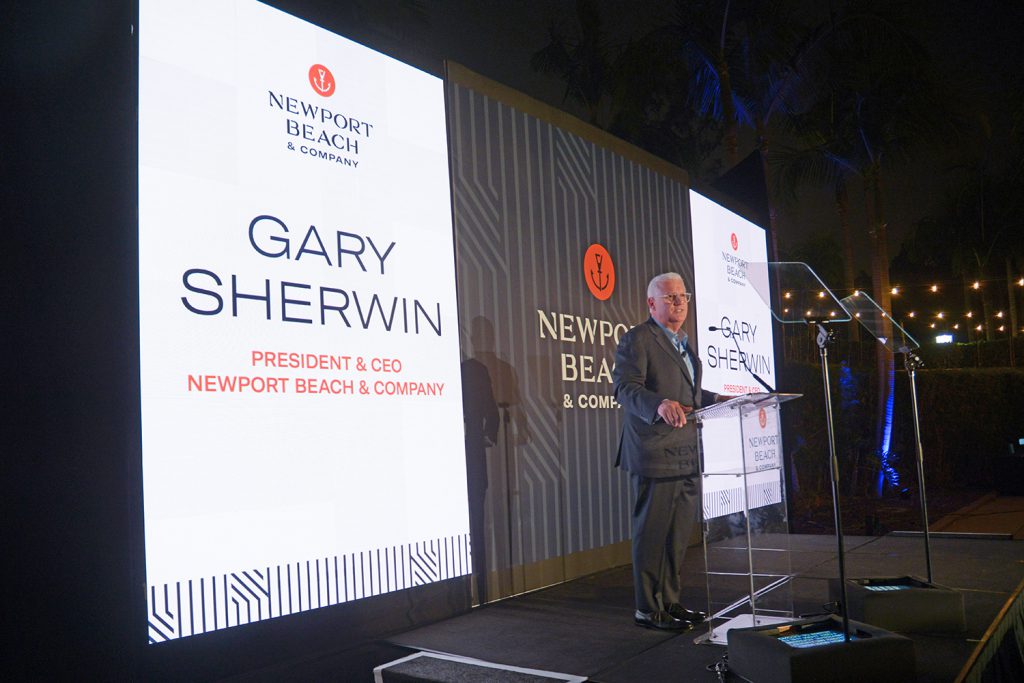
Tourism has been the chief economic engine that drives our city’s economy, and that of much of Orange County—especially Anaheim with Disneyland and the Convention Center.
Two years ago, the global pandemic caused that engine to run out of gas.
“This is the tourism industry’s George Baily moment,” Newport Beach & Co. CEO Gary Sherwin told the Newport Beach Independent in May of 2020, referring to the main character in the film “It’s a Wonderful Life.”
“We’re discovering what life is like without tourism. It isn’t pretty. Like in the movie, you look at what the void is, and in Newport Beach it’s devastating. Without visitors the economy is suffering; it will have an impact on quality of life in the city.”
“We were at 80 percent hotel occupancy in February (2020), and by the end of March we were down to 30 percent occupancy,” continued Sherwin. “It’s the biggest drop ever in our city and across the nation. We have three major properties open: Lido House, Marriott, and Pelican Hill. Everyone else is shut down. Even hotels that are open are at single digit occupancy. It’s a devastating blow. It’s going to take a while to dig out.”

Now, more than two years and a truckload of shovels later, we’ve finally dug our way out of the pandemic, and all indicators are that 2023 will be a robust year for the tourism and hospitality industries.
In August, Visit Anaheim hosted a Destination Forecast featuring three guests experts offering their analysis of the travel and tourism industry: Erin Francis-Cummings, President and CEO of Destination Analysts; Leona Reed, Associate V.P. of Global Marketing for Visit California, and Michael Dominguez, President and CEO of Associated Luxury Hotels International.
Their presentations offered insights into how consumers are feeling about their decision making on spending, travel and leisure activities.
But first, a look back at 2019, when Anaheim had 24.2 million visitors, including nearly three million foreign tourists. More than $9.3 billion was spent by Anaheim visitors in Orange County (and many visitors include Newport Beach on their agenda).
One year later, hotel occupancy was down to 18 percent, there was a 51 percent decrease in spending, and a 46 percent decrease in leisure and hospitality jobs across Orange County.
Disneyland closed, conventions ceased, concerts stopped, sporting events were held sans fans.
Then in 2021, things started to turn around. Disneyland reopened, conventions returned (albeit with covid restrictions), Angel Stadium welcomed back fans (with social distancing seating and other protocols in place).
According to Visit Anaheim, year to date visitor data shows the area has returned to 99.6 percent of the 2019 numbers.

In Francis-Cummings’ presentation, she stated that nearly half of American travelers are firmly confident they can travel safely in the current environment, and that travel anxiety is decreasing.
As to what is keeping Americans from traveling, the top reason (according to a survey) was the price of gasoline, followed by the high cost of traveling, personal financial reasons, and airfare costs. Safety concerns about contracting Covid-19 was listed fifth.
Fears of a recession and inflation are having an impact on travel. The price of gasoline was also a factor, although prices have since decreased significantly.
Anecdotally, local airports have seen increased passenger traffic on major holidays, but also myriad flight cancellations.
Despite those issues, the mood in the tourism industry is mainly upbeat.
Reed told the audience that Visit California’s recovery forecast shows that in 2020, travel spending was 55 percent of what it was in 2019. Last year, spending was at 69 percent. This year, it’s predicted to be at 94 percent. By 2023, travel spending will be at 107 percent of 2019 figures, and that percentage continues to rise in subsequent years. And while international travel lags behind both domestic leisure and business travel, even that segment is predicted to recover between 2024 and 2025.
Locally, things are looking good.
According to Visit Anaheim, its 2022 confirmed bookings for the Anaheim Convention Center are up 11 percent compared to 2019. Strategically focused on booking short-term convention business to fuel local recovery, Visit Anaheim will host 90 percent of these Anaheim events from 2022–2024.
These meetings, conventions and events for the Anaheim Convention Center will bring 188,700 room nights to local hotels and $444 million in economic impact to the community because of attendees dining, shopping and entertaining while in town.
For the remainder of 2022, Visit Anaheim has 21 groups utilizing the Anaheim Convention Center. Combined, these 21 groups will bring $222 million in economic impact to the local community.
“Visit Anaheim had a strong summer with shows like NAMM, VidCon, Star Wars Celebration and many more that returned to the Anaheim Convention Center. These shows along with a strong leisure return contributed to an 82 percent occupancy seen in Anaheim and Garden Grove for the month of June,” said Junior Tauvaa, Chief Sales Officer for Visit Anaheim. “That’s only five percent behind occupancy levels seen in June 2019, which shows we are getting that much closer to reaching pre-pandemic levels.”
Closer to home, Sherwin recently told the Newport Beach Independent that “Newport Beach more than a lot of places came out of Covid much more resilient and in better shape. Even during Covid we were able to sustain ourselves which has to do with the short-term rental industry. If you look at the city budget, and the transient occupancy tax, it’s because of short term rentals—they really saved our bacon.”
“We came out of this remarkably well,” added Sherwin. “It’s a testament to Newport Beach being a drive market, and it’s a healthy city with a healthy lifestyle.”
According to Sherwin, Newport Beach had a good summer, but we’re still in a transition period. As he noted, tourism has lots of pieces to it, and “you need all the pieces of the pie to have a good pie. The pieces that have been missing are meetings and conventions.”

Fortunately, VEA just opened and The Pendry (formerly The Island Hotel) will open next year, yet the hospitality labor shortage means there have not been enough staff to service all the hotel rooms in the city. Restaurants have been suffering through the same labor issues.
But overall, says Sherwin, the market has been resilient, yet they are not back at 2019 numbers yet.
“In 2019 our staff booked 110,000 meeting and convention rooms for 2019 and years beyond. Last year we were at about 40,000, this year it’s 75,000. The Meetings market was hit first, and it has struggled to get its footing. Groups are smaller as people segue into a post-Covid world, but we have much more momentum than I expected.”
Overall, said Sherwin, “I’m feeling bullish about where the industry is headed.”
